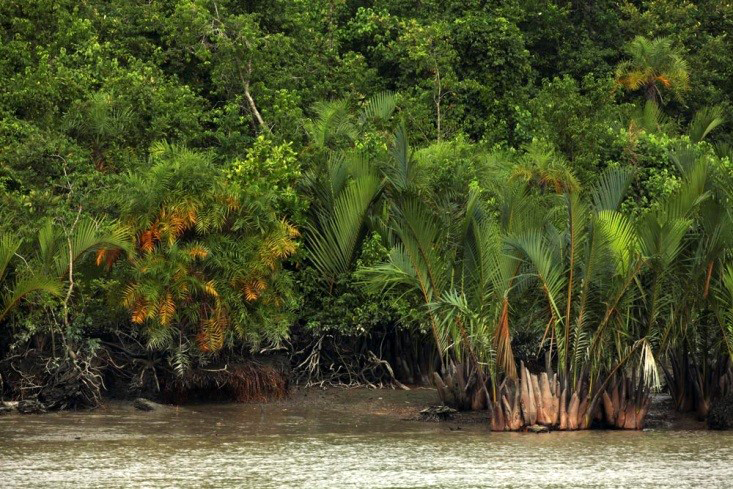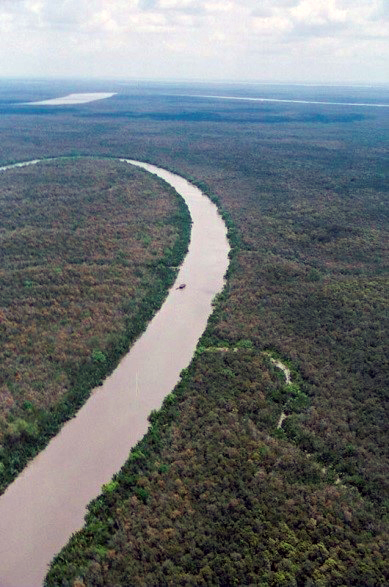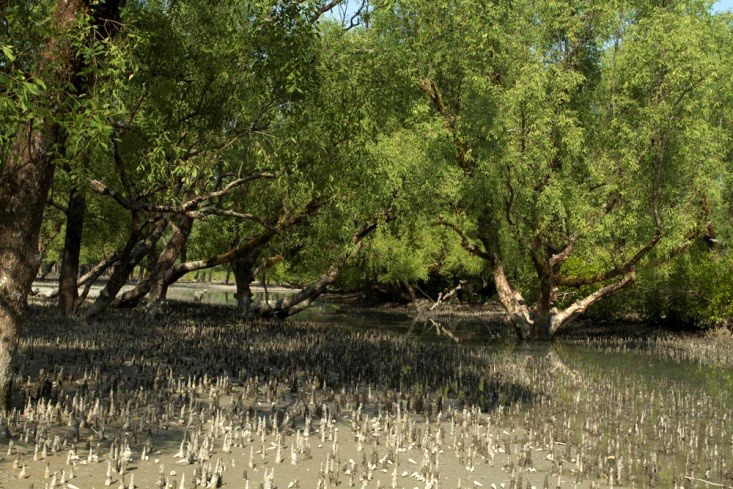
The Sundarbans. Photo: Bengal Pix Limited
The Sundarbans is located at the delta of the Ganges, Brahmaputra and Meghna rivers systems on the Bay of Bengal. It is declared a World Heritage in 1997 by United Nations Educational Scientific and Cultural Organization (UNESCO).
 Research on Sundarbans using remote sensing Landsat satellite images from 1975 to 2006 and geographical information system shows that near to the vicinity of human settlement, areal changes of this forest are not observed significantly. However, growth of vegetation follows up and down on time because of salinity and frequency of sever cyclone passing through this forest.
Research on Sundarbans using remote sensing Landsat satellite images from 1975 to 2006 and geographical information system shows that near to the vicinity of human settlement, areal changes of this forest are not observed significantly. However, growth of vegetation follows up and down on time because of salinity and frequency of sever cyclone passing through this forest.
Now the days sever cyclone hits this forest frequently such as one in less than ten years that is caused of global climate change, increased average temperature and spatio-temporal variability in precipitation. This mangrove forest is decreased by 19.3% due to severe tropical cyclone in 1977 and 1988. The dense forest is damaged by about 50%. Sundarbans takes approximately 28 years to recover from damage by a sever cyclone.
 The biodiversity of Sundarbans depends to upstream fresh water flow through it that is controlled by Farakka barrage in India. Day by day, upstream fresh water flow is decreasing therefore salinity of water channel in the forest is increasing. Biodiversity is mostly threatened by salinity of water.
The biodiversity of Sundarbans depends to upstream fresh water flow through it that is controlled by Farakka barrage in India. Day by day, upstream fresh water flow is decreasing therefore salinity of water channel in the forest is increasing. Biodiversity is mostly threatened by salinity of water.
Therefore, the future of Sundarbans depends to the frequency of sever cyclone but more importantly it is threaten by increasing salinity that is caused of inadequate flow of upstream fresh water by manmade Farkka barrage.
Article in Landscape & Environment : Vegetation changes of Sundarbans based on Landsat imagery analysis between 1975 and 2006.
Link>>
Contacts: Dr. Md. Tariqul Islam, institutionen för geovetenskaper, Göteborgs universitet 031 -786 28 04, 073- 730 10 97, tariqul.islam@gvc.gu.se
Photo: Bengal Pix Limited

 Research on Sundarbans using remote sensing Landsat satellite images from 1975 to 2006 and geographical information system shows that near to the vicinity of human settlement, areal changes of this forest are not observed significantly. However, growth of vegetation follows up and down on time because of salinity and frequency of sever cyclone passing through this forest.
Research on Sundarbans using remote sensing Landsat satellite images from 1975 to 2006 and geographical information system shows that near to the vicinity of human settlement, areal changes of this forest are not observed significantly. However, growth of vegetation follows up and down on time because of salinity and frequency of sever cyclone passing through this forest. The biodiversity of Sundarbans depends to upstream fresh water flow through it that is controlled by Farakka barrage in India. Day by day, upstream fresh water flow is decreasing therefore salinity of water channel in the forest is increasing. Biodiversity is mostly threatened by salinity of water.
The biodiversity of Sundarbans depends to upstream fresh water flow through it that is controlled by Farakka barrage in India. Day by day, upstream fresh water flow is decreasing therefore salinity of water channel in the forest is increasing. Biodiversity is mostly threatened by salinity of water.